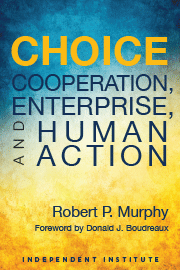Voters frequently support measures that sound noble and beneficial but end up causing serious mischief—and often hurt the very groups the measures were intended to help.
A well-known example is price controls, which include minimum wage laws and rent control. These can cause unemployment among low-skill workers and apartment shortages for those without connections.
But that’s not all. Not by a long shot.
Here are five more examples of unintended consequences.
1. “Shoot, Shovel, and Shut Up”
The Endangered Species Act and other laws restrict how landowners can use their property if it is discovered that their actions may adversely affect vulnerable wildlife. Besides the injustice of violating property rights, this regulation produces perverse results.
Imagine a landowner in the Midwest who had plans to sell to an outside developer who wanted to build a shopping mall. One morning, a few days before closing the deal, the man is sipping coffee and looking off his back porch into the woods. He suddenly sees a woodpecker that he recognizes as a protected species. What will the man do, if he follows pecuniary incentives? Is he going to call up federal bureaucrats and tell them the good news?
No. The man will probably go get his gun and shovel and never speak of this incident to anyone.
2. Seat Belt Legislation Kills
In the typical debate over seat belt mandates—in which drivers can be heavily fined if caught driving without buckling up—advocates of liberty tend to stress individuals’ “right to be stupid” while others claim that public safety trumps absolute freedom. Ideology aside, do such laws make us safer?
Economist Sam Peltzman looked at the evidence after some states enacted seat belt legislation, while others did not. He found that drivers did buckle up more frequently because of the government penalties but that traffic fatalities were roughly unchanged.
Because seat belts made people feel safer, they drove just a little more recklessly.
True, the probability of dying in a car crash went down, if you were in a crash, because wearing a seat belt definitely helps you survive a typical accident. However, the states that passed the seat belt legislation saw an increase in rates of traffic accidents. Because people felt safer, they drove just a little more recklessly. No individual driver wakes up and says, “I’m going to get in a fender bender today,” but with millions of people driving hours per day, 365 days per year, we will definitely see more accidents in the aggregate if people are even slightly more aggressive on the margin.
Peltzman found that total fatalities were about the same. The death rate for motorists crept down, but this was offset by a higher death rate among pedestrians and cyclists hit by cars. Some groups obviously did not benefit from the higher prevalence of seat belt usage.
3. Stricter Vehicle Fuel Economy Mandates Do Little for the Environment
The federal government imposes minimum corporate average fuel economy (CAFE) standards on certain vehicles. Some states wanted to “do more” for the environment, so they passed tighter mandates. In other words, states like California imposed higher mile-per-gallon requirements on cars sold in California than the federal government insisted on.
But the way the states structured their rules led to a significant “leakage.” If a car manufacturer increased the average fuel economy for its vehicles sold in California, for example, then those cars counted as part of its “fleet” in calculating the average fuel economy for its cars sold in the nation as a whole. The manufacturer could then get away with selling cars that had lower fuel economy in the states that did not supplement the federal rule, and they were still satisfying both state and national standards. Thus, the California rule as originally designed led to fewer emissions per vehicle-mile in California—but not nearly as much in the nation as a whole. Some economists estimated this “leakage” to be as high as 74 percent. The hodgepodge of standards simply raised the total costs of vehicles while doing little to reduce total US emissions.
4. Jane Jacobs Combats City Planning
Fans of Austrian economics should not be surprised to learn that Jane Jacobs, the champion of the American city, found several flaws with typical bureaucratic city planners. For example, zoning regulations broke up the spontaneous growth of cities into “residential” and “commercial” sections, spawning crime and other social ills.
Originally, apartments were interspersed with shops, so that the owners could always keep an eye on their businesses and on their children. This “natural surveillance” was destroyed with zoning and other regulations, not to mention the interstate highways that would rip neighborhoods apart and the austere “housing projects” that placed most adults far away from the street and thus unable to monitor and shoo away unsavory characters. Zoned neighborhoods became unsafe neighborhoods.
5. Three Strikes Mean You’re Out
In an understandable reaction to “liberal” judges who would give slaps on the wrist to repeat offenders, the 1990s saw a wave of automatic sentencing legislation to take away judges’ discretion. This included California’s famous 1994 “Three Strikes and You’re Out” rule (Proposition 184), where someone convicted of a third felony would get 25 years to life. Currently, 24 states have some form of “three strikes” legislation.
One problem with these rules is that many acts are felonies that most people would consider petty, such as bringing a smoke bomb to high school. In California, one man with two prior felony convictions was sentenced to 25 years to life for being with a friend who got caught selling $20 of cocaine to an undercover cop.
An unintended consequence of the “three strikes” rules is that someone with two prior felony convictions now has a serious incentive to evade arrest for a third. And in fact, empirical studies of Los Angeles data suggest that more police officers have been killed because of this effect.
The Upshot
Incentives matter. It’s not enough for voters to endorse legislation that has a nice title and promises to do something good. People need to think through the full consequences of a policy, because often it will lead to a cure worse than the disease.









